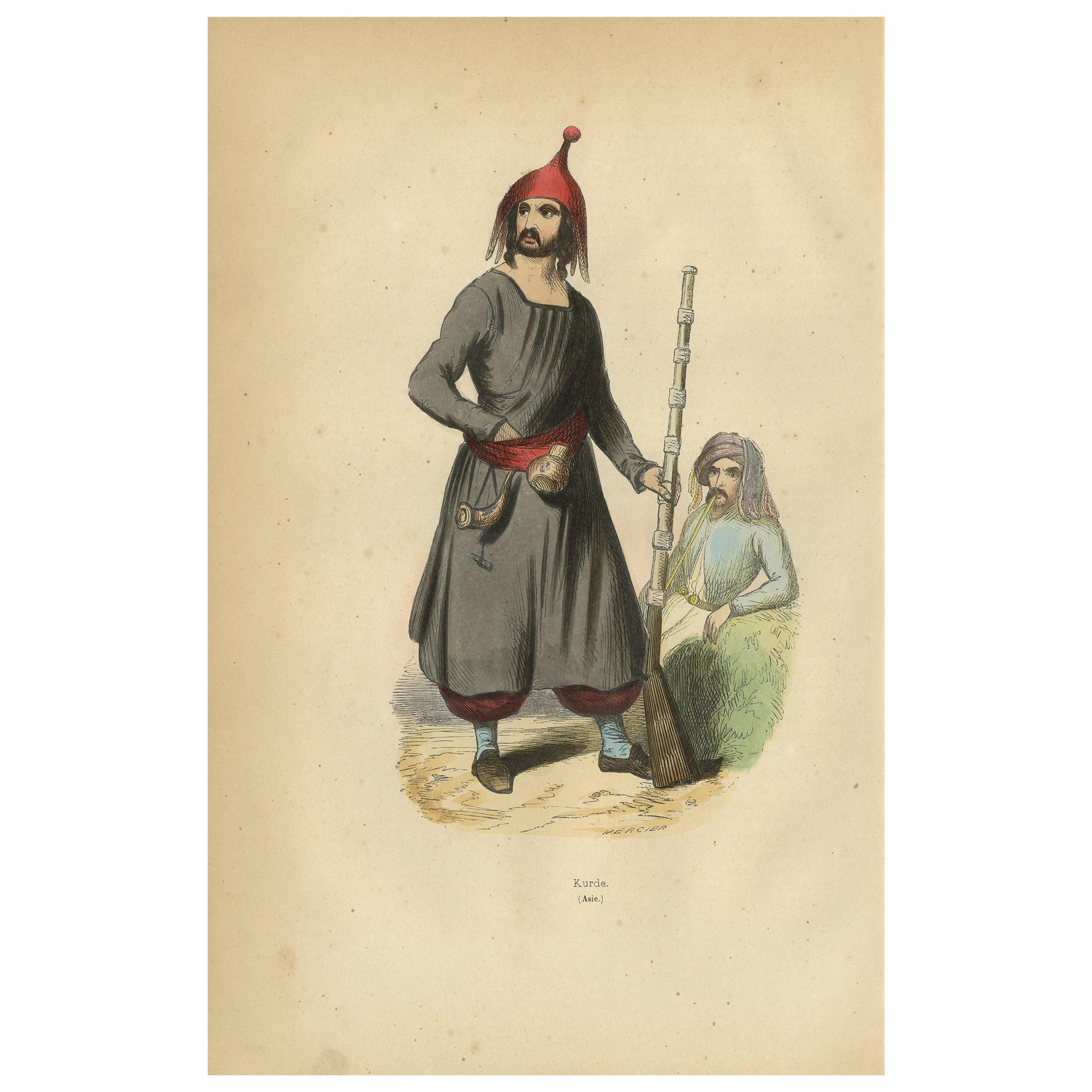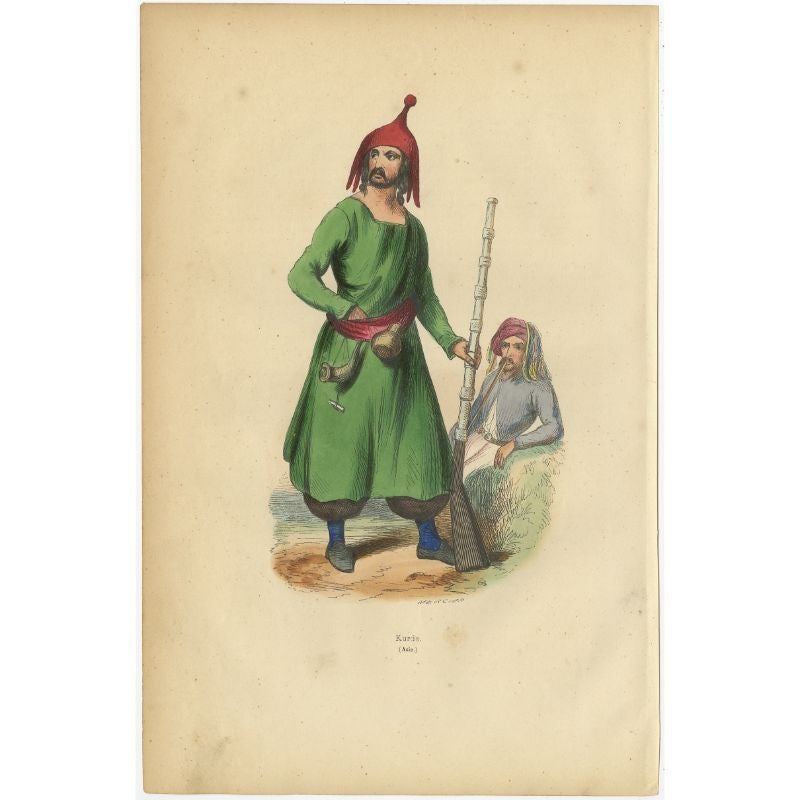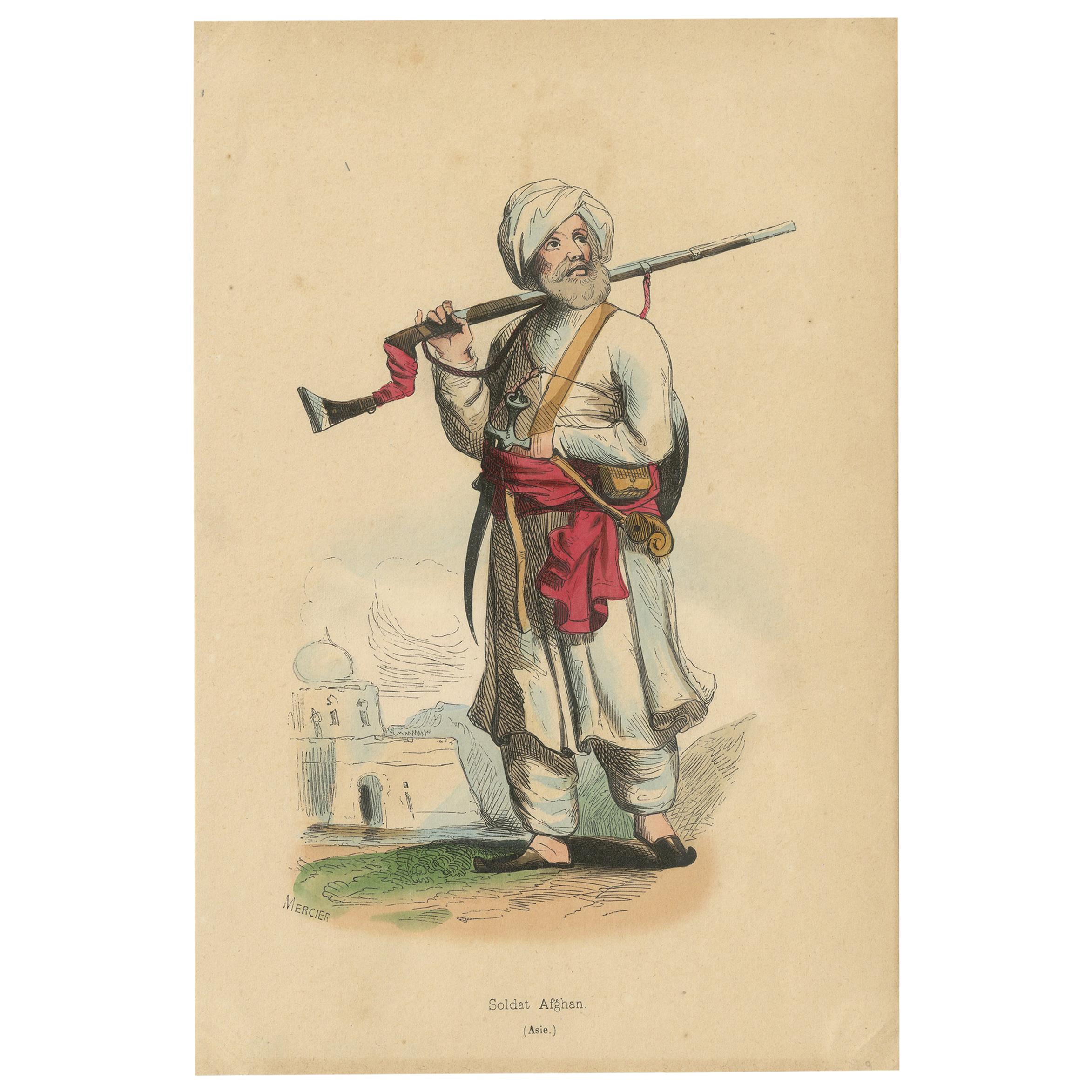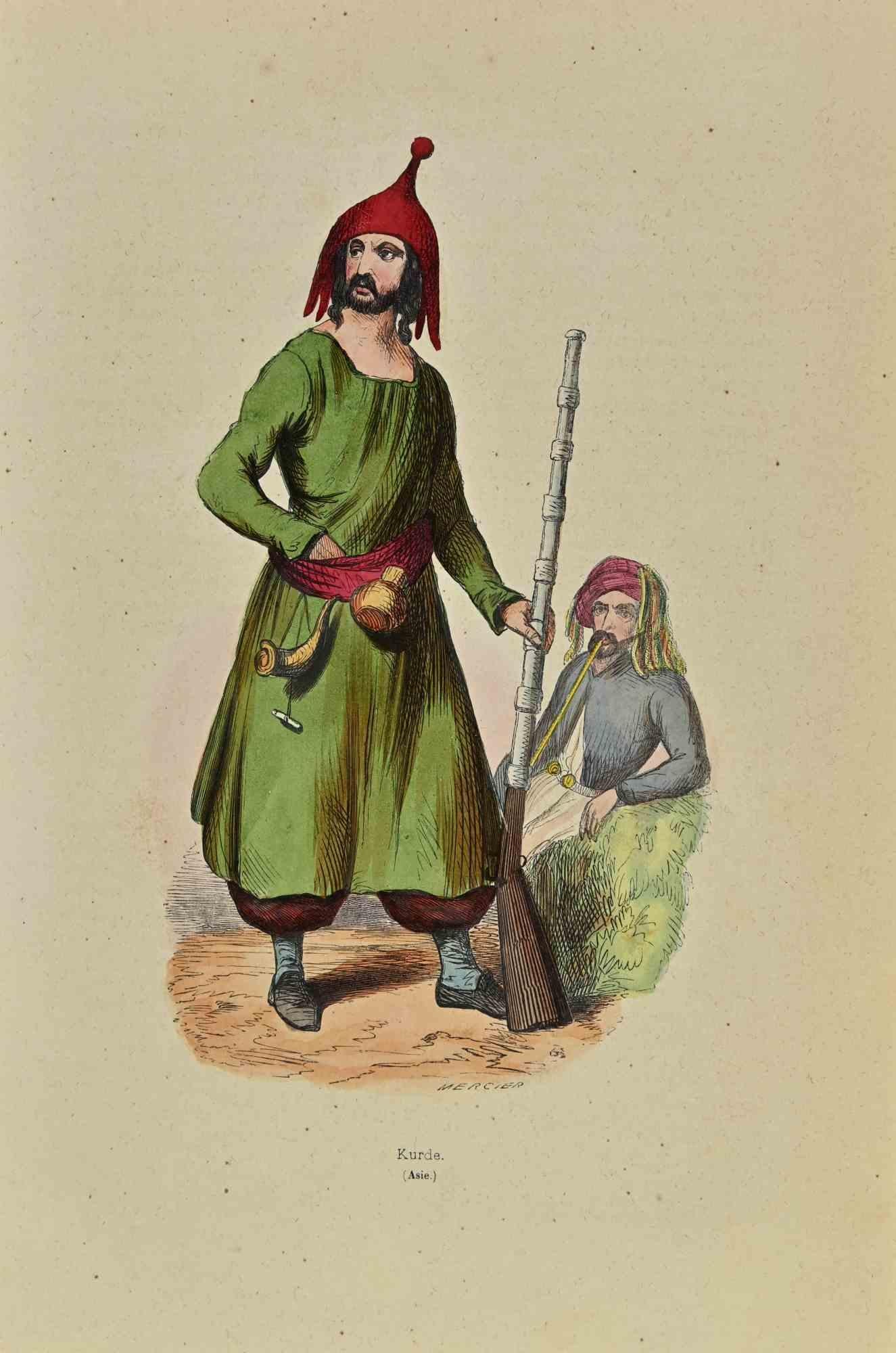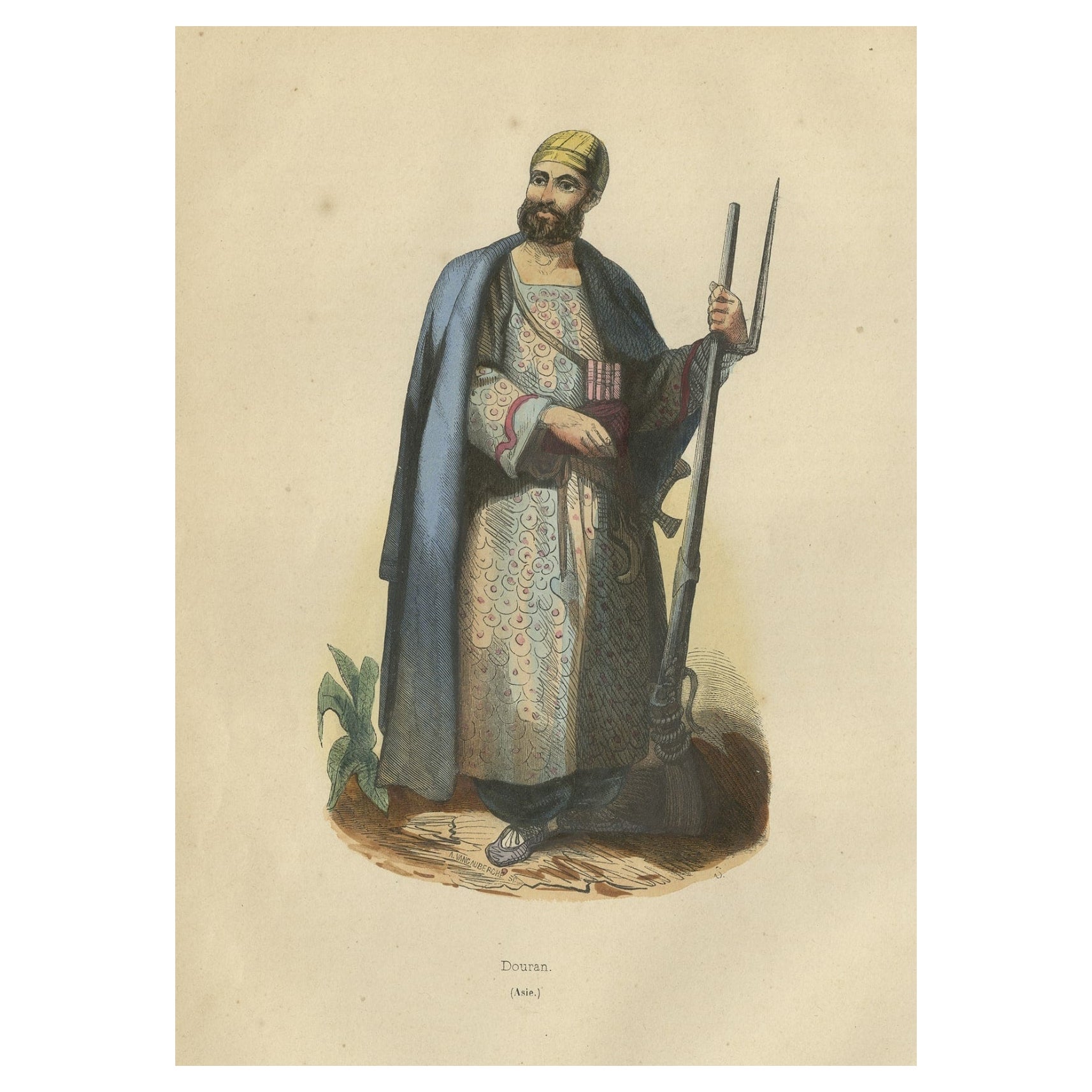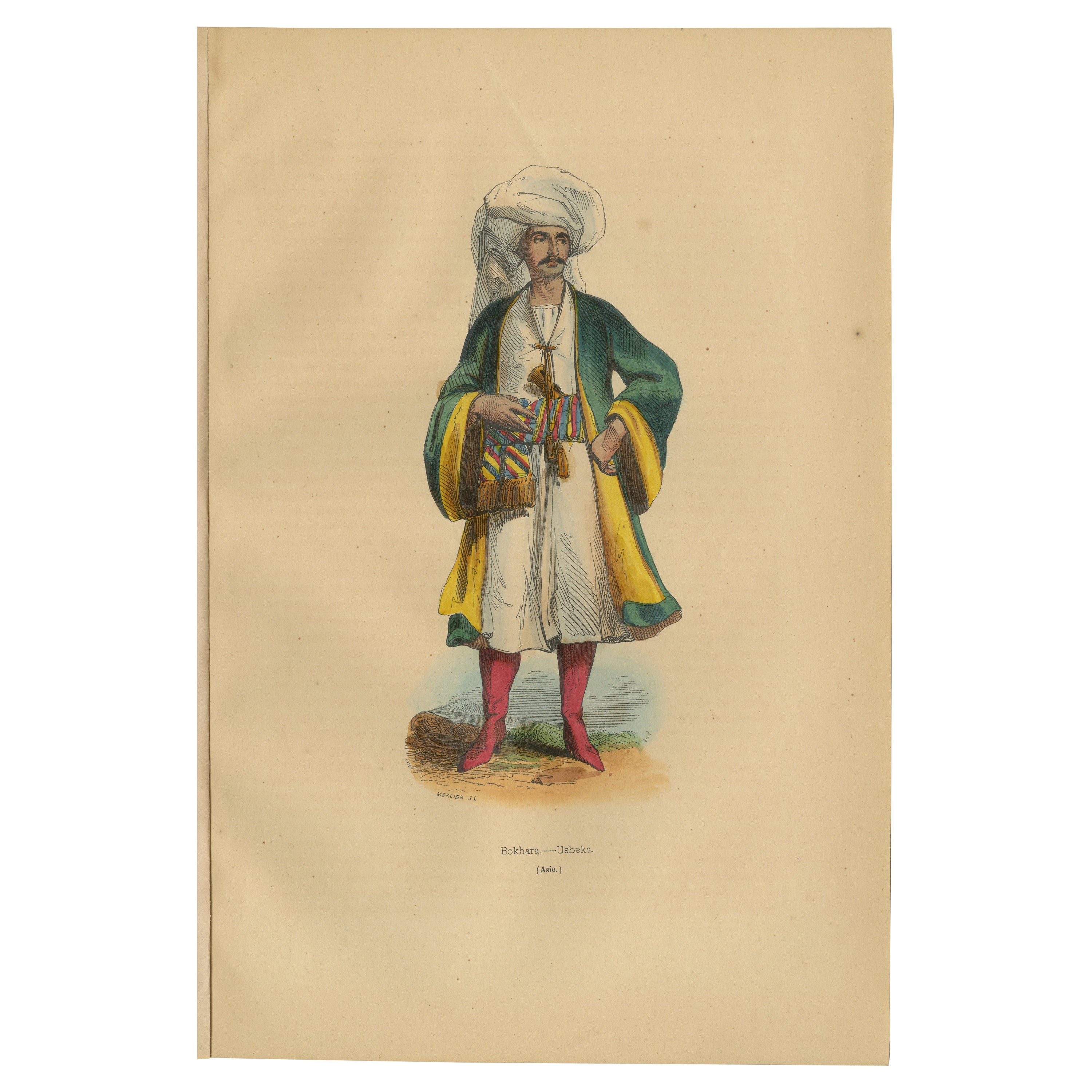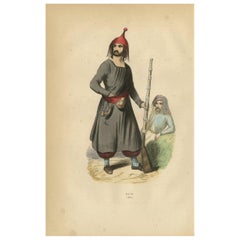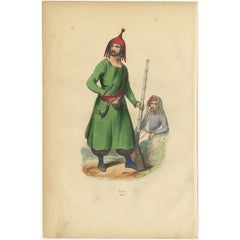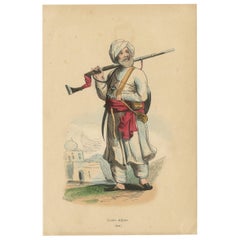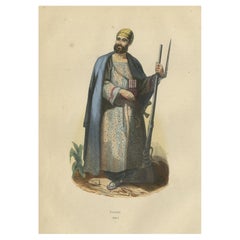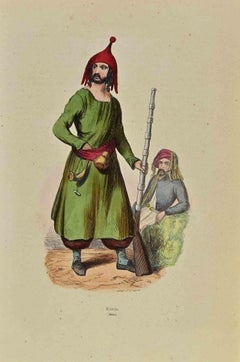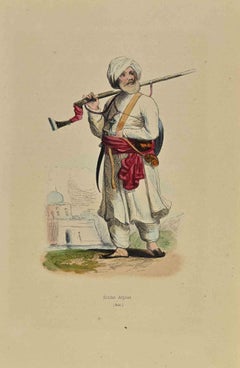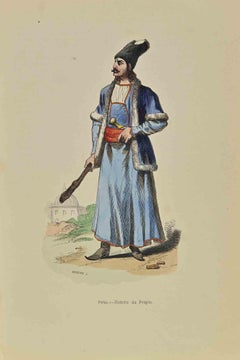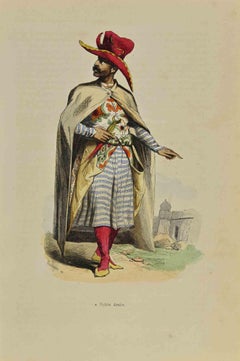Items Similar to Kurdish Warrior in Traditional Attire from 19th Century Lithograph
Want more images or videos?
Request additional images or videos from the seller
1 of 6
Kurdish Warrior in Traditional Attire from 19th Century Lithograph
$152.97
$191.2120% Off
£113.24
£141.5620% Off
€128
€16020% Off
CA$211.67
CA$264.5920% Off
A$233.33
A$291.6620% Off
CHF 122.09
CHF 152.6120% Off
MX$2,862.88
MX$3,578.6020% Off
NOK 1,536.86
NOK 1,921.0720% Off
SEK 1,437.21
SEK 1,796.5120% Off
DKK 974.59
DKK 1,218.2420% Off
About the Item
Title: "Kurdish Warrior in Traditional Attire from 19th Century Lithograph"
This hand-colored lithograph titled "Kurda" showcases a Kurdish man in traditional attire, complete with distinctive elements such as a red hat and a long green robe. This print is part of the Asia volume of "Moeurs, Usages et Costumes de tous les Peuples de Monde" (Customs, Manners, and Dress of All the Peoples of the World), published in 1844 in Paris by Poiree, Pilout, Duterte, and Martinon.
The image was produced by an anonymous engraver following designs by Auguste Wahlen, with contributions from artists like Evrard Duverger, L. Markaert, and R. King.
Attractiveness:
The print is notable for its vivid coloring and detailed depiction of the Kurdish warrior's costume and accessories. The use of Arabic gum enhances the depth and glossiness of the colors, making the lithograph strikingly attractive. It captures the rich cultural heritage and attire specific to the Kurdish people of the time.
The lithograph of the Kurdish man offers a rich visual representation that captures the traditional attire and accessories associated with Kurdish culture during the 19th century. Here are some details that make this print particularly interesting:
Weapon:
The weapon carried by the Kurdish figure appears to be a type of long rifle, possibly a jezail. The jezail was commonly used by various tribes in the Middle East and Central Asia, known for its long, curved barrel which enhanced its accuracy at long distances. It was a favored weapon among mountainous tribes due to its utility in rugged terrains.
Headgear:
The red hat worn by the figure is known as a "kolah," a traditional Kurdish hat. This type of hat often has a pointed top and is sometimes adorned with a tassel or other decorative elements. It is a distinctive piece of Kurdish cultural attire, reflecting elements of identity and tradition.
Horn:
The horn attached to the man’s belt is likely a powder horn, used for carrying gunpowder. Powder horns were essential accessories for firearms before the advent of cartridge-based ammunition, allowing the user to reload their weapon efficiently. The use of a horn, often crafted from animal horn, helped to keep the gunpowder dry and was a common sight among warriors and hunters who relied on muskets or rifles.
Other Details:
Additionally, the print shows the man wearing a sash around his waist, often used to hold weapons or tools, reinforcing the image of the man as equipped for defense or battle. The clothing and the overall pose of the figure convey a sense of readiness and alertness, traits valued in a warrior culture.
These elements together not only depict the physical appearance of a 19th-century Kurdish warrior but also provide insight into the functional aspects of his attire and equipment, reflecting his societal role and the practical needs of his environment.
Keywords for Searching:
To find similar prints, keywords such as "Kurdish traditional costume prints," "1844 Wahlen lithograph," "hand-colored lithographs," "historical Kurdish attire," and "chromolithography art" would be useful. These terms help locate historical art pieces that focus on the cultural and traditional representations of different ethnic groups from the 19th century.
- Dimensions:Height: 10.12 in (25.7 cm)Width: 6.7 in (17 cm)Depth: 0 in (0.02 mm)
- Materials and Techniques:
- Period:
- Date of Manufacture:1844
- Condition:Condition: Good, given age. Faintly browned, and with some small stains. Some glue remains (from binding) in the far left margin (not affecting image). General age-related toning and/or occasional minor defects from handling. Please study the scans.
- Seller Location:Langweer, NL
- Reference Number:Seller: BG-12722-661stDibs: LU3054341390632
About the Seller
5.0
Recognized Seller
These prestigious sellers are industry leaders and represent the highest echelon for item quality and design.
Platinum Seller
Premium sellers with a 4.7+ rating and 24-hour response times
Established in 2009
1stDibs seller since 2017
2,613 sales on 1stDibs
Typical response time: <1 hour
- ShippingRetrieving quote...Shipping from: Langweer, Netherlands
- Return Policy
Authenticity Guarantee
In the unlikely event there’s an issue with an item’s authenticity, contact us within 1 year for a full refund. DetailsMoney-Back Guarantee
If your item is not as described, is damaged in transit, or does not arrive, contact us within 7 days for a full refund. Details24-Hour Cancellation
You have a 24-hour grace period in which to reconsider your purchase, with no questions asked.Vetted Professional Sellers
Our world-class sellers must adhere to strict standards for service and quality, maintaining the integrity of our listings.Price-Match Guarantee
If you find that a seller listed the same item for a lower price elsewhere, we’ll match it.Trusted Global Delivery
Our best-in-class carrier network provides specialized shipping options worldwide, including custom delivery.More From This Seller
View AllAntique Print of a Kurd by Wahlen, 1843
Located in Langweer, NL
Antique costume print titled 'Kurde (Asie)'. Original antique print of a Kurd. This print originates from 'Moeurs, usages et costumes de tous les peuples du monde' by Auguste Wahlen.
Category
Antique Mid-19th Century Prints
Materials
Paper
$95 Sale Price
20% Off
Antique Hand-Colored Print of a Kurd, 1843
Located in Langweer, NL
Antique costume print titled 'Kurde (Asie)'. Original antique print of a Kurd. This print originates from 'Moeurs, usages et costumes de tous les peuples du monde' by Auguste Wahlen....
Category
Antique 19th Century Prints
Materials
Paper
$143 Sale Price
20% Off
Antique Costume Print of an Afghan Soldier by Wahlen, '1843'
Located in Langweer, NL
Antique costume print titled 'Soldat Afghan'. Original antique print of an Afghan soldier. This print originates from 'Moeurs, usages et costumes de tous les peuples du monde' by Aug...
Category
Antique Mid-19th Century Prints
Materials
Paper
$95 Sale Price
20% Off
Antique Costume Print of an Arab 'Douran' with Weapons in Asia, 1843
Located in Langweer, NL
Antique costume print titled 'Douran (Asie)'.
Original antique print of an Arabian man. This print originates from 'Moeurs, usages et costumes de tous ...
Category
Antique 1840s Prints
Materials
Paper
$133 Sale Price
20% Off
1844 Lithograph of a Bukharan Uzbek: Traditional Attire and Craft
Located in Langweer, NL
"1844 Lithograph of a Bukharan Uzbek: Traditional Attire and Craft"
Description: This 1844 lithograph captures a traditional Bukharan Uzbek man, from the renowned series "Moeurs, Usages et Costumes de tous les Peuples de Monde" by Auguste Wahlen.
Published in Paris using the technique of handcoloured lithography, enhanced with Arabic gum on vellin paper, this print vividly portrays the rich cultural attire unique to Bukhara, Uzbekistan.
The man's elaborate robe and distinctive headwear highlight the regional fashion and craftsmanship. The print’s appeal lies in its detailed depiction of historical dress and accessories, offering a window into the cultural diversity of Central Asia. Such prints are treasured for their historical value and intricate artistry, making them highly desirable to collectors and enthusiasts of ethnographic art.
The lithograph depicting a man from Bukhara, Uzbekistan, offers several intriguing cultural and historical insights:
1. Traditional Attire: The attire of the Bukharan man, particularly the elaborate robe and turban, is a rich display of Uzbek textile craftsmanship. Traditional robes, often made from silk and cotton, are adorned with intricate ikat patterns—a dyeing technique where threads are dyed before weaving. This style is emblematic of Uzbekistan's well-known textile industry.
2. Turban Significance: The turban, known locally as a "doppa" or "tubeteika," is more than just practical headwear; it serves as a cultural symbol of status and identity. The style, color, and way it is worn can convey information about the wearer's social status, region, and even his clan affiliations.
3. Historical Context: Bukhara was a pivotal Silk Road city, making it a melting pot of cultures, languages, and religions. The diverse influences are reflected in the traditional clothing, which blends Persian, Turkic, and nomadic styles.
4. Artistic Technique: The use of handcoloured lithography in the 19th century allowed for high-quality, detailed prints that were more accessible to the European public. This technique involved drawing on limestone with a greasy medium, then using water and oil-based ink to print vibrant images, which were then painted by hand.
5. Cultural Preservation: Prints like this serve not only as artwork but also as historical documents that preserve and share the cultural heritage of regions less known to the Western world at the time. They played a crucial role in educating and influencing perceptions about distant cultures during the 19th century.
This print, therefore, is not just a beautiful piece of art but a deep well of cultural history and craftsmanship, reflecting the rich tapestry of life in Central Asia during the 19th century.
Keywords:
- Antique Uzbek prints
- Handcoloured lithography
- 19th-century Central Asian costumes
- Auguste Wahlen lithographs
- Traditional Bukharan attire
- Ethnographic art prints
- Collectible cultural lithographs
- Historical Uzbek fashion
- Asian historical prints
- Vintage Uzbek art...
Category
Antique 1840s Prints
Materials
Paper
$143 Sale Price
20% Off
Antique Print of a Persian Man in Traditional Clothing and with a Dagger, 1843
Located in Langweer, NL
Antique costume print titled 'Perse - Homme du Peuple'. Original antique print of a Persian man. This print originates from 'Moeurs, usages et costumes de ...
Category
Antique 19th Century Prints
Materials
Paper
$133 Sale Price
20% Off
You May Also Like
Kurdish - Lithograph by Auguste Wahlen - 1844
Located in Roma, IT
Kurdish is a lithograph made by Auguste Wahlen in 1844.
Hand colored.
Good condition.
At the center of the artwork is the original title "Kurde".
The work is part of Suite Moeurs...
Category
1840s Modern Figurative Prints
Materials
Lithograph
Afghan Soldier - Lithograph by Auguste Wahlen - 1844
Located in Roma, IT
Afghan Soldier is a lithograph made by Auguste Wahlen in 1844.
Hand colored.
Good condition.
At the center of the artwork is the original title "Soldat Afghan".
The work is part ...
Category
1840s Modern Figurative Prints
Materials
Lithograph
Persian, Man of the People - Lithograph by Auguste Wahlen - 1844
Located in Roma, IT
Persian, Man of the People is a lithograph made by Auguste Wahlen in 1844.
Hand colored.
Good condition.
At the center of the artwork is the original title "Perse. Homme du Peuple...
Category
1840s Modern Figurative Prints
Materials
Lithograph
Noble Arab - Lithograph by Auguste Wahlen - 1844
Located in Roma, IT
Noble Arab is a lithograph made by Auguste Wahlen in 1844.
Hand colored.
Good condition.
At the center of the artwork is the original title "Noble Arabe".
The work is part of Sui...
Category
1840s Modern Figurative Prints
Materials
Lithograph
Circassian - Lithograph by Auguste Wahlen - 1844
Located in Roma, IT
Circassian is a lithograph made by Auguste Wahlen in 1844.
Hand colored.
Good condition.
At the center of the artwork is the original title "Circassien".
The work is part of Suit...
Category
1840s Modern Figurative Prints
Materials
Lithograph
A Pair of 19th C. Engravings Depicting the Costumes and Weapons of Afghani Men
Located in Alamo, CA
These hand-colored lithographs are from "Character and Costumes of Afghanistan", written by Lockyer Willis Hart (of the 22nd Bombay Native Infantry). The lithographs were created by ...
Category
1840s Realist Portrait Prints
Materials
Lithograph
